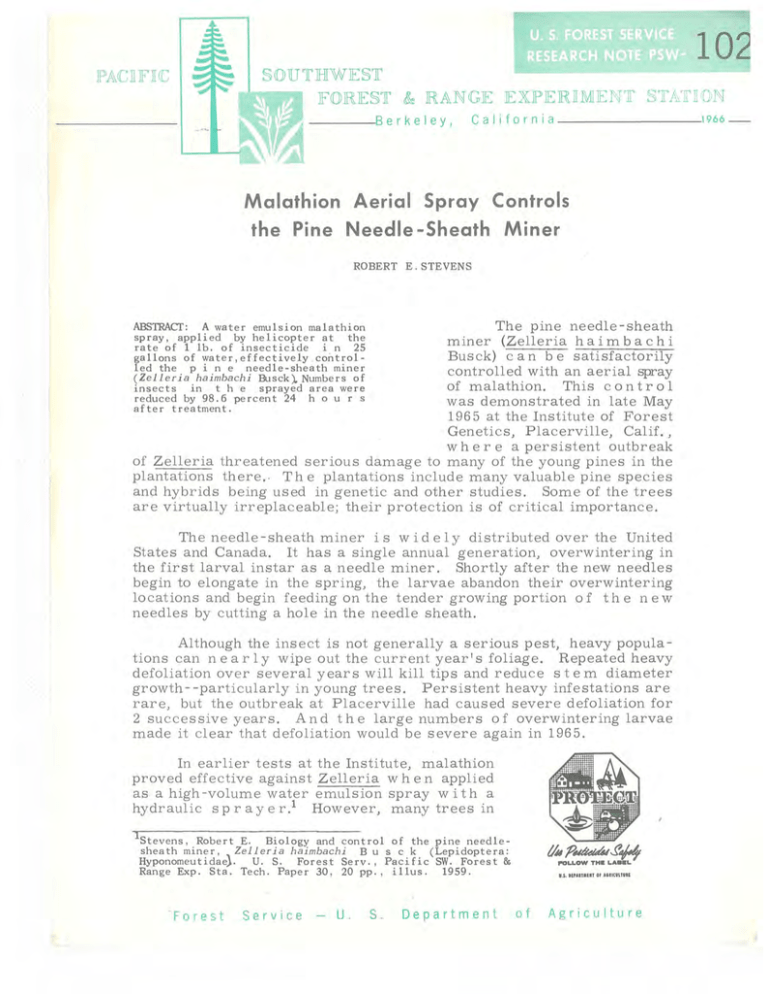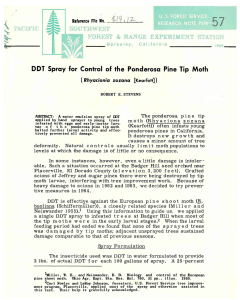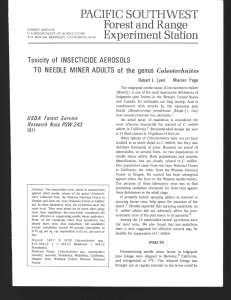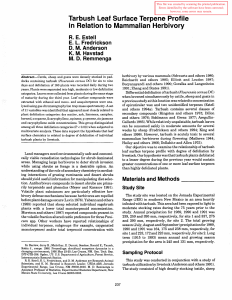102 Malathion Aerial Spray Controls §OUTJHIWJE§T
advertisement

102 JPACllFliCC §OUTJHIWJE§T FORJEST & RANGJE JEXJPJERliM JENT - - - - IBe r k e I ey, § T.A~lfliON C a lifo r n i a __________1966 _ Malathion Aerial Spray Controls the Pine Needle -Sheath Miner ROBERT E.STEVENS The pine needle-sheath miner (Zelleria h aim b a chi Busck) can be satisfactorily controlled with an aerial spray of malathion. This con t r 0 I was demonstrated in late May 1965 at the Institute of Forest Genetics, Placerville, Calif., w her e a persistent outbreak of Zelleria threatened serious damage to many of the young pines in the plantations there., The plantations include many valuable pine species and hybrids being used in genetic and other studies. Some of the trees are virtually irreplaceable; their protection is of critical importance. ABSTRACT: A water emulsion malathion spray, applied by helicopter at the rate of 1 lb. of insecticide i n 25 gallons of water,effectively . controlled the p i n e needle-sheath miner (Zelleria haimbachi Busck~Numbers of insects in t h e sprayed area were reduced by 98.6 percent 24 h 0 u r s after treatment. The needle -sheath miner i s wid ely distributed over the United States and Canada. It has a single annual generation, overwintering in the first larval instar as a needle miner. Shortly after the new needles begin to elongate in the spring, the larvae abandon their overwintering locations and begin feeding on the tender growing portion 0 f th e new needles by cutting a hole in the needle sheath. Although the insect is not generally a serious pest, heavy populations can n ear 1 y wipe out the current year's foliage. Repeated heavy defoliation over several year s will kill tips and reduce s t em diameter growth - -particularly in young trees. Persistent heavy infestations are rare, but the outbreak at Placerville had caused severe defoliation for 2 successive years. And the large numbers 0 f overwintering larvae made it clear that defoliation would be severe again in 1965. In earlier tests at the Institute, malathion proved effective against Zelleria w hen applied as a high -volume water emulsion spray wit h a hydraulic sprayer.1 However, many trees in IStevens, Robert E. Biology and control of the pine needlesheath miner, Zelleria haimbachi Bus c k (Lepidoptera: Hyponomeutidae}. u. S. Forest Serv., Pacific SW. Forest & Range Exp. Sta. Tech. Paper 30, 20 pp., illus. 1959. ' Forest Service - U. S. Department I/MP~~+'f ~LLOW of TH. LA • • L Agriculture the plantations were now too tall to reach with ordinary ground equipment. Therefore an aerial application was considered necessary to reach the tops of t1i~e -trees. The objective of the spraying would be to minimize defoliation in portions of the plantations that had already been hard hit. This was to be accomplished by killing the larvae before they were able to do much feeding. Parasites, which are an important natural control factor in Zelleria, could not be relied on for help as most of them kill their hosts only after the larval feeding period is finished. Spray Formulation and Application A water emulsion spray oJ malathion was formulated to provide 1 lb . of the insecticide in 25 gallons of water. The spray was applied by helicopter on May 27, 1965, at the rate of 25 gallons per acre. Eight acres were treated. The helicopter flew from a site next to the plantations. The work took about 1 hour. At the time of sprayi ng, all the larvae had abandoned the overwintering mines and were mining the needle sheaths; some were already well developed and in the final larval instars. An est imated 20 percent of the total potential defoliation had already occurred by the time the spray was applied. Results and Discussion The results ' of the treatment were evaluated by counting live larvae on selected branches in the sprayed area and in an adjacent unsprayed check area. Prespray counts made the day before spraying and postspray counts made 24 hours after spraying showed the following: Treatment: Sprayed Check Number live larvae in 100 tips (prespray) (postspray) 703 10 695 673 Reduction (percent) 98.6 The treatment was highly effective in reducing the needle-sheath miner population and in reducing defoliation. Spraying several days earlier most likely would have prevented practically all defoliation. The Author_ _ _ _ _ _ _ _ _ _ _ _ _ _ _ _ _ _ __ ROBERT E. STEVENS , formerly an entomologist at the Station. is now with the Branch of Forest Insect Research , U.S. . Forest Service , Washington , D . C . -2 -






